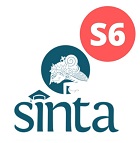EDUKASI PENCEGAHAN CACINGAN SEBAGAI IMPLEMENTASI PROGRAM GENERASI SADAR STUNTING
EDUKASI PENCEGAHAN CACINGAN SEBAGAI IMPLEMENTASI PROGRAM GENERASI SADAR STUNTING
DOI:
https://doi.org/10.47522/jmm.v3i1.131Keywords:
treatment, prevention, intestinal worms, CSA, stuntingAbstract
Referring to the problem, the impact of worms related to stunting, it is necessary to undertake community service activities (CSA) regarding education on the prevention and treatment of intestinal worms as the implementation of the stunting awareness generation program. This community service activity aims to equalize understanding and provide knowledge about the prevention and treatment of intestinal worms that are integrated with the stunting program. The method of implementing this activity is carried out online in the form of a webinar using the Zoom Meeting application. The target audience includes high school/vocational high school students, students, teachers, lecturers, and health workers. CSA implementation includes preparation (producing materials and publication flyers), implementation (exposure to materials on prevention and treatment of intestinal worms in children), and evaluation (pre-test and posttest assessments). The realization of this activity showed the number of participants was 117 which included 104 students, 10 health workers, and 3 housewives. The indicators for the success of this activity are indicated by the increase in the average score from the pre-test of 63.19 to the post-test of 74.86 with a percentage increase in knowledge of the prevention and treatment of intestinal worms by 16%. This CSA concludes that participants can understand the material on prevention and knowledge of worms. The recommendation from this activity is that it is necessary to carry out direct follow-up activities in worm-endemic areas in the form of treatment measures, prevention programs, and periodic monitoring in worm-endemic areas in collaboration with local health centers.
References
Dinas Kesahatan Kabupaten Bekasi, D. K. K. (2018). Profil Kesehatan Kabupaten Bekasi Tahun 2018.
Bora, A.M., Samsuri dan Oka, Ida Bagus Made. (2014). Vermisidal dan Ovisidal Ekstrak Daun Pepaya
Terhadap Cacing Ascaris suum Secara In Vitro. Indonesia Medicus Veterinus, 3(2), 84–91.
Djuma, A. W., Susilawati, N. M., Djami, S. W., Rantesalu, A., Agni, N., Rohi Bire, W. L. ., Foekh, N.
P., Octrisdey, K. dan Bessie, M. F. (2020). Siswa SD Bebas Kecacingan Di SD Inpres Besmarak
Dan SD Gmit Biupu. Jurnal Pengabdian Masyarakat Sasambo, 2(1), 114.
https://doi.org/10.32807/jpms.v2i1.599
Far-Far, G. (2021). Efektifitas Penggunaan Aplikasi Zoom Meeting Dalam Pembelajaran Di Masa
Pandemi Covid-19. ISTORIA : Jurnal Pendidikan Dan Sejarah, 17(1).
Juariah, S., Irawan, P. M., Rahmita, M. dan Kurniati, I. (2017). Pemeriksaan, Pengobatan, Dan
Penyuluhan Kebersihan Diri Untuk Mencegah Dan Mengobati Kecacingan Pada Anak Usia
Sekolah Guna Meningkatkan Konsentrasi Belajar Pada Anak. Dinamisia : Jurnal Pengabdian
Kepada Masyarakat, 1(1), 32–36. https://doi.org/10.31849/dinamisia.v3i1.2729
Kementerian Bappenas. (2018). Pedoman Pelaksanaan Intervensi Penurunan Stunting Terintegrasi di
Kabupaten/Kota. Rencana Aksi Nasional Dalam Rangka Penurunan Stunting: Rembuk Stunting,
November, 1–51. https://www.bappenas.go.id
Mubarokah, W. W., Nurcahyo, W. dan Kurniasih, K. (2019). Daya Anthelmintik Infusa Biji Buah
Pinang (Areca catechu) Terhadap Cacing Ascaridia galli Secara in Vitro. In Jurnal Sain Veteriner
(Vol. 36, Issue 2, p. 254). https://doi.org/10.22146/jsv.40337
Panjaitan, R. G. P., Elisa, E. dan Wahyuni, E. S. (2021). The Anthelmintic Activity of Cawat Anuman
(Bauhinia sp.) Leaves Against Ascaridia galli worms. Pharmacognosy Journal, 13(3), 626–630.
https://doi.org/10.5530/pj.2021.13.79
Kementerian Kesehatan Republik Indonesia. (2017). Peraturan Menteri Kesehatan Republik Indonesia
Nomor 15 Tahun 2017. 111.
Satriawan, D. A., Putra, R. R. F. A., Giri, T. P. D., Warouw, B. P., Azis, N. E. A. dan Rahma, A. H.
(2019). Meningkatkan kesadaran Masyarakat Terhadap Penyakit Kecacingan di Bantaran Sungai
Ciliwung, Jakarta Timur. Prosiding PKM-CSR, 2(1), 362–368.
Trisnani (2017). Pemanfaatan Whatsapp Sebagai Media Komunikasi Dan Kepuasan Dalam
Penyampaian Pesan Dikalangan Tokoh Masyarakat. Jurnal Komunika : Jurnal Komunikasi, Media
Dan Informatika, 6(3). https://doi.org/10.31504/komunika.v6i3.1227
Downloads
Published
How to Cite
Issue
Section
License

This work is licensed under a Creative Commons Attribution-NonCommercial-ShareAlike 4.0 International License.
Jurnal Mitra Masyarakat memberikan akses terbuka terhadap siapapun agar informasi pada artikel dapat bermanfaat bagi orang banyak. jurnal dapat diakses tanpa dipungut biaya, sesuai dengan lisensi creative commons yang digunakan.







